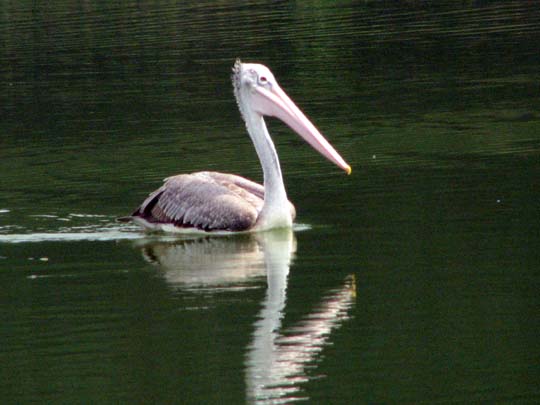Grey Pelican {
Pelicanus philippensis }
-RagooRao
At the onset of winter, just after the rains come to an end, a vulture sized squat bird with the most graceful flight
arrives to all the lakes and water bodies. A grey boat shaped bird with an enormous flat long thick beak, a long neck and short thick legs is really a sight to see both in flight and landing on the lakes in slow motion and gradually
folding the wings to the body-Arrive the Grey Pelican. It is also called a Spot-billed pelican as it has spots on the beak. The typical mark of a Pelican is the loosely hung enormous pouch of skin from it's lower beak. This gets exaggerated when the bird scoops
up fish from the water and holds it in the pouch for a while before swallowing it with head upturned.
The birds are normally greyish white with blackish wing quills; a slightly brownish tail indicates it is the male. Distribution
is throughout the Country in well- watered tracts. These birds are locally migratory and resident in some localities. 
When the Pelicans arrive at a lake they all land in a semicircle and they seem to hunt fish co-operatively. They all
start swimming in a semicircle and close in to a shallow bank, driving the fish towards shallow waters and scoop them up with their beaks, their beak pouches acting as fishing net.
It is really nice to watch pelicans buoyantly floating in the water with a stiff neck with apparently no signs of movement, seriously driving the fish towards shallow waters, to finally scoop them up with their enormous beaks.
 When they are not foraging, they flock together or solitarily on mud-banks or among short reeds and preen themselves.
These birds are quite tolerant of each other and do not seem to squabble when they are preening and sunning themselves. The birds are very cautious and the slightest intrusion makes them glide into the water and swim for a little distance before they take
off with their squat bodies effortlessly from the water. They take off and circle around for some time to see what disturbed them.
When they are not foraging, they flock together or solitarily on mud-banks or among short reeds and preen themselves.
These birds are quite tolerant of each other and do not seem to squabble when they are preening and sunning themselves. The birds are very cautious and the slightest intrusion makes them glide into the water and swim for a little distance before they take
off with their squat bodies effortlessly from the water. They take off and circle around for some time to see what disturbed them.
The nesting season is between Nov to April. These birds nest in colonies not far from the water bodies, in tall trees
and even on coconut palms. A large twig platform reminiscent of an Eagle's nest is their home for raising the clutch. Three chalk-white eggs are laid and the chicks are raised with fish regurgitated from their gizzards. The chicks are voracious and the parents
have to make frequent fishing trips.
Whether both the parents share all domestic chores is to be ascertained through a study. The birds’ nesting in colonies
makes it difficult to identify individual bird to study unless they are tagged for study and observation.
Some Villages in Karnataka, where Pelicans arrive in early November to nest are really a sight to see. The villagers even consider
this a Good Omen for the village for prosperity. These have become tourist spot and also a good place to study the Parental behavior of the Birds. One such famous village is " Kokkre Bellur" midway off the Mysore- Bangalore highway. "Kokkrey" meaning Pelicans
in Kannada language and Bellur is the name of the Village and hence " Kokrey-Bellur.